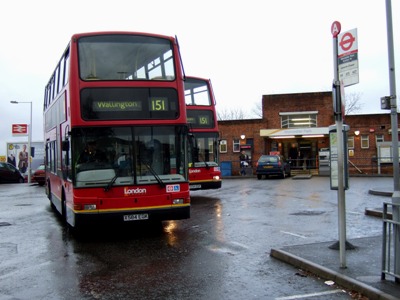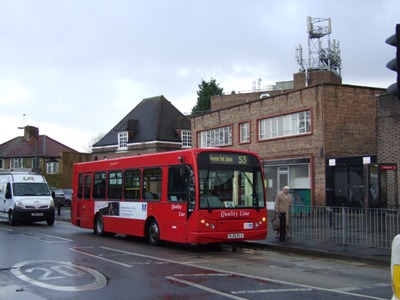Transport history by Derek Fisk
Part 4 - Up to date
Continued from Part
3
In the mid-eighties the era of tendering dawned and brought with
it the shedding of bus routes running outside the GLC area. This
saw the 293 become an LCBS route in July 1986, which soon became
LCSW. The 213 was allocated to “Kingston Bus” under another
tendering change in 1987. The 93 had been removed from Senhouse
Road the previous year and diverted via the link road behind the
pub to reach Church Hill Road. In August 1987 a special contract
bus service T2, funded by the Tesco Superstore at Shannon Corner,
ran to Wrythe Green via the 213, 93 and 157, but gradually faded
away during the 90s. The first example of buses entering
non-traditional suburban roads in the area came in November 1988
when the 151 was diverted from the London Road at the Woodstock to
run via Tudor Drive to the Beverley.
Historic route 213 still
plies between Kingston and Sutton Garage. Here in December
2007, Sutton's EVL36 is working short on a Sunday,
heading for the historic
(but hardly currently valid) destination of North Cheam Queen
Victoria.
Photo © Peter
Osborn
Several more changes affected the 213 until in September 1990
London General won the route through tendering and it settled down
as Kingston to Sutton Garage. That company, originally the western
half of London Buses Wandle District now operated the three red bus
routes in North Cheam, the 93, 151 and 213. The only other bus
route was the 293 operated by London & Country, although that
eventually passed to Epsom Buses (Quality Line) who now run Citaros
on the route. The 726 remained, after the final withdrawal of the
725, with Heathrow Airport as its western terminus. This is now the
X26 operated hourly from Croydon to Heathrow by Metrobus.
 Moving into the 1990s saw further incursions into
suburban side roads. The 413 replaced the 213 between Belmont and
Sutton in 1990 and was extended in August 1991 along Cheam Road to
Gander Green Road to London Road and thence via the 151 to the
Beverley. From there it was extended via Cannon Hill Road to
Morden, later being transferred to Epsom Buses in 1997.
Moving into the 1990s saw further incursions into
suburban side roads. The 413 replaced the 213 between Belmont and
Sutton in 1990 and was extended in August 1991 along Cheam Road to
Gander Green Road to London Road and thence via the 151 to the
Beverley. From there it was extended via Cannon Hill Road to
Morden, later being transferred to Epsom Buses in 1997.
A view of Worcester Park station forecourt in
November 2007. Where once the 32 and the 189 terminated
(because they could not pass under the bridge), now the 151 runs
east under that bridge via Sutton to Wallington. London
General Sutton's PVLs 184 and 154 stand positioned to avoid a
reversing manoeuvre off the nose-in stands.
Photo © Peter Osborn
Mobility bus services also entered the London bus scene from
1984 onwards, with a fragmented network of services operating on a
few days a week to main shopping centres, aimed at elderly and
disabled people, with vehicles capable of taking wheelchairs. Such
routes often penetrated areas not served by mainstream bus routes.
The first example of a mobility bus service in the North Cheam area
started in April 1992 with route 940 operated by Javelin Coaches.
This route ran on Tuesdays and Fridays from Epsom to Kingston via
Ewell, Stoneleigh Broadway, Briarwood Road, London Road to N Cheam
and then via 213 to Portland Avenue and then the back roads of
Motspur Park to Tescos. A second route, the 928 started Tuesdays
only in June 1992 operated by Kentish Bus. This ran from Malden,
Adela Avenue via West Barnes Lane and Motspur Park to the 213 and
thence to Sutton.
During this period, Epsom Buses set up some commercial bus
routes in the area using large minibuses. Two of these ran through
the Stoneleigh Estate area hitherto ignored by bus operators. One
of the main reasons for lack of services on this estate was the
road layout, which was dissected by a railway line with only a
small pedestrian bridge to cross the line between the 213 route and
the 406 route nearly two miles to the south. These routes are now
subsumed into Surrey County Council routes K9 and K10. Another new
bus route in recent years has been the S3, run initially by
Tellings Golden Miller and now Epsom Buses, which runs from
Worcester Park via Green Lane, turning off Cheam Common Road to
reach Dorchester Road and Clarkes Avenue, then crossing London Road
into the Brocks Estate to reach Sutton. Narrow roads built in the
30s but now lined with parked cars and with speed humps to deter
rat-running punishing the buses probably explain the reluctance of
bus operators to extend routes into such areas.

Epsom Buses (trading as
Quality Line) run many of the local services in their area,
although they have just lost the 293 in the latest tendering
round. Here is East Lancs Myllennium-bodied Dart SD41 in
Worcester Park.
Photo © Peter
Osborn
North Cheam is also now served by two night bus routes, the 93
which was initially called the N93 but is now a 24 hour service
from Putney Bridge to Priory Road, North Cheam and the N213 from
Kingston to West Croydon. Another night bus route a few miles to
the south, which operated commercially by Centra, ran from Epsom to
Stoneleigh and Ewell. Numbered N500, this ran only Friday and
Saturday nights until 1 am, but no longer runs.
Summing up, what stands out starkly is that the original two
major routes crossing at the Queen Victoria are little different
from the position in 1921 when the 113 was introduced. There is
still a bus route from Morden to Epsom, augmented as far as North
Cheam by the same 93 introduced in 1930, while the east west route
is effectively the 84 year old 113 with a slightly different number
and a different routeing between Norbiton and New Malden. During
the intervening period a lot of new housing has been built and bus
services have been increased to serve the principal flows of people
until those new populations saw fit to abandon public transport in
favour of their own private vehicles. Limited stop services have
come and gone on the London Road, but the cross-suburban initiative
of 1953 has survived in a somewhat truncated form. The other major
change is that some penetration of secondary roads has come at
last, but is it too late? Their frequencies do not match those on
the major routes.
Wherever one chooses to look, there are factors affecting the
development of bus services in an area, be they shopping trends,
employment opportunities, home entertainment, the population
demographics, ethnic mix, fare structures or the capacity of the
road network to cope with the demands placed upon it. We hope to
have demonstrated that whatever changes had taken place in the bus
network over the past 90 years, each of these factors were
interrelated. In other words, buses do not operate in a vacuum.
This article is based on a talk given to the
London Historical Research Group of the Omnibus Society by
Derek Fisk in 2005. Derek grew up in the area in the 1930s and
40s. Red-RF.com is indebted to both Derek and the LHRG for
permission to reproduce the item.
Back to:
Introduction
Part 1
Part 2
Part 3